PROTECTIVE MIMICRY IN ANIMALS.
BY ALFRED RUSSEL WALLACE, F.L.S., AUTHOR OF "THE MALAY ARCHIPELAGO," ETC.
In a former article (pp. 128-137), on the "Protective Colours of Animals," we endeavoured to illustrate the purpose and origin of all those peculiarities of colouring which tend to conceal animals from their enemies or from the prey which they wish to capture; we showed how widespread were such colours in nature, and how often it happened that what seem showy colours when we examine the species in confinement, or when preserved in a museum, are really protective when the animal is seen in its native haunts and in the attitude it usually assumes when at rest. We referred to many cases of special imitation by insects of vegetable substances—of leaves or flowers, bark or moss—sometimes so wonderfully accurate as to deceive the eye of the experienced naturalist as well as that of the hungry bird. But besides all these, we called attention to a totally different kind of protection, always associated with conspicuous instead of protective colouring. A number of insects (and some of the higher animals) possess secretions which are so nauseous as to render them generally uneatable. This is a perfect protection against being devoured, but it would be no protection against being hunted, and caught, and often killed, if there was nothing to distinguish these from the great majority of eatable insects. But eatable insects (if soft and defenceless) are almost always protected by obscure or green tints harmonising with their surroundings. Evidently, therefore, the best way to distinguish the uneatable kinds would be that they should be of gay and brilliant tints, strongly contrasted with their surroundings, and readily distinguishable from a considerable distance. Marvellous to relate, this is actually the case; and the uneatable insects are, almost without exception, gaudily and conspicuously coloured. A number of such cases were adduced, especially among our native caterpillars, and proofs of their non-edibility were given.
We now propose to deal with this part of the subject more fully, in order to explain what is meant by "protective mimicry"—perhaps the most interesting and the most wonderful of all the phenomena of colour among animals. It is only among the teeming forms of life of tropical forests that the best cases of mimicry are to be met with, and we shall therefore now have to deal with objects for the most part unfamiliar to the British collector. We hope, however, by means of numerous illustrations, to make the subject intelligible to our readers, and especially to such as have some knowledge of our native insects.
Mimicry is the term applied to the phenomenon presented by certain species which, being themselves eatable, and belonging to groups which are attacked and devoured by numerous enemies, obtain protection by their close resemblance to some of the brightly coloured species which are free from attack on account of their nauseous odour or general inedibility. In most cases it is not a general but a special resemblance which serves this purpose, sometimes carried so far that the mode of flight and general habits are imitated, as well as colour and marking. The most numerous examples of mimicry occur among butterflies, but there are almost equally remarkable cases among beetles and other orders of insects, as well as a few among reptiles and birds. We will, therefore, first describe the groups of butterflies which are the subjects of mimicry by other groups.
In all tropical forests butterflies are abundant, and very varied in size, form, colouring, and mode of flight. Some fly with great rapidity, others have a zigzag, jerking mode of flight, and many such are adorned with brilliant colours. Great numbers of Satyridæ and Erycinidæ keep near the ground, with a slow hovering flight, and these have generally a sober style of coloration; while many of the showy species have their under-sides adorned with rich dark marblings, which render them inconspicuous as soon as they settle on a leaf or branch. But there are three great families—the Danaidæ, Heliconidæ, and Acræidæ—one or other of which is everywhere abundant both in species and individuals, and which are always remarkable, for their beauty or their conspicuousness; for their slow and lazy flight; for never trying to conceal themselves, and never flying high up in the air. The under-sides of their wings, too, are always coloured nearly the same as the upper, or, at all events, never present markings tending to concealment. These three families are closely allied to each other, and should, perhaps, form sub-divisions of one family, and they are believed to be most nearly related to the Nymphalidæ (to which family belong our tortoiseshells and fritillaries), of which they are a special development. They all have
the cell of the hind-wings closed, whereas in the Nymphalidæ it is always open; but they agree with the latter family in having the first pair of legs short and imperfect in both sexes, but more especially in the males, and in the pupæ being freely suspended by the tail.
All three groups have the peculiarity of possessing a powerful odour, which appears to pervade the whole body. When a specimen is caught and pinched between the fingers, a yellow fluid oozes out, which has a strange pungent smell and stains the skin. This has been observed with the Heliconidæ of South America, the Acræidæ of Africa, and the Danaidæ of Asia and Australia, and it appears to be of a very similar nature in all these groups. This pungent yellow secretion is very distasteful to birds and other insectivorous animals, so that the butterflies in question are never persecuted as others are. Some persons have doubted whether birds catch butterflies at all. Swallows, however, have been seen chasing white butterflies even in England; but in the tropics insectivorous birds belonging to many distinct families are much more numerous, and no eatable insects escape them. Mr. Belt, when in Brazil, watched a pair of puff-birds catching butterflies during half an hour, capturing many and carrying them to their young; but though numbers of Heliconidæ were flying slowly about, the birds neither noticed nor made any attempt to catch them. Neither Mr. Bates nor myself ever saw these butterflies attacked by birds, or lizards, or predacious insects, though they often rest exposed, hanging on the tips of leaves where they would be easily captured; and though the wings of butterflies that have been caught and eaten are often found lying in the forest paths, those of the Heliconidæ are never found among them. Dragon-flies were seen to catch Pieridæ in Natal, but never the slower-flying Acræidæ; while among the wings of butterflies found under certain trees where they assemble to feed on the exuding sap, and are captured by mantises and other insectivorous creatures, no Acræidæ or Danaidæ were ever found. We may consider it, therefore, to be an established fact that these three groups of butterflies enjoy almost perfect immunity from attack, owing to their offensive taste and odour; and their peculiarities of form and colour as well as their mode of flight, seem to be so well known to all insectivorous creatures, that they are recognised at a considerable distance, and thus not only escape being devoured, but are generally free from all pursuit or molestation. No doubt young birds or lizards sometimes make the trial, but the result is so disagreeable that they very soon learn what to avoid.
The peculiar odour is found in the caterpillar and the chrysalis of these butterflies, as well as in the perfect insects, and the result of this freedom from persecution is that they swarm in the forests to a greater extent than any other butterflies. The Heliconidæ of South America and the Danaidæ of the Malay Islands may always be found, even when other butterflies are very scarce, and there are many places where hardly any other kinds can be seen. It is evident, therefore, that if any other butterflies, belonging to eatable groups, should closely resemble any of these inhabiting the same districts, they would certainly be mistaken for them, and so obtain protection. Wherever these groups are found there are such cases of mimicry, of which we will now give some of the more interesting examples.
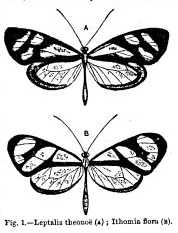
In tropical America the Heliconidæ1 are immensely abundant, about 400 species having been described up to 1871, while, as many new ones are discovered every year, the number cannot be now much less than 500 species. They are also, as already stated, very abundant in individuals, and as all these are, without exception, uneatable, it is not surprising that insectivorous creatures have got to know them well and avoid them. They differ wonderfully among themselves in colour, some being black or blue, banded with yellow or white; others rich red, with yellow bands and rays; others rich brown and yellow spotted; while an immense number have transparent wings, either simply veined or delicately tinged with yellow, brown or purplish. Yet, amid all this variety, the general form, the style of marking, and the
1 They have now been divided into two families, Heliconidæ and Danaidæ; but I keep the old nomenclature for simplicity.
mode of flight are so peculiar, that even species never seen before are recognised at a glance as belonging to this family.
In the same forests are found a considerable number of the totally distinct family of Pieridæ, to which belong our well-known "cabbage," "orange-tip," and "brimstone" butterflies. Most of these are white or yellow, variously marked and shaded, but still unmistakably Pieridæ; but there is one genus—Leptalis—which has more elongate wings than usual and a weaker flight, and these vary greatly in colour, some being white, others yellow or yellow and black, while others are coloured exactly like the Heliconidæ. The wonderful thing is, that the resemblance is not general but special. The coloured Leptalis does not look like a new species of Heliconidæ, but exactly imitates an existing species, and always a species which inhabits the same locality. Thus the transparent-winged, black-banded Ithomia flora (one of the Heliconidæ) is accompanied, at Cupari on the Tapajos river, by Leptalis theonoë (Fig. 1), which so closely resembles it that it cannot be distinguished when on the wing; while in other parts of the Amazon valley distinct species of Ithomia, with orange-red bands and spots, are imitated by varieties of this Leptalis. At Ega, on the Upper Amazon, the handsome brown-black and yellow-banded Mechanitis obscura (one of the Heliconidæ) is accompanied by Leptalis Egaëna, closely resembling it in size, colours, and markings, and both have long yellow antennæ (Fig. 2). 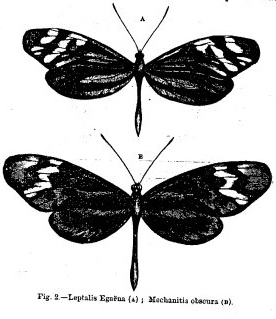
Still more remarkable is the large and handsome yellow-and-black Methone psidii (one of the Heliconidæ), accompanied by Leptalis orise, equally large and very similarly marked and coloured; and in this case both have long black antennæ with a yellow club
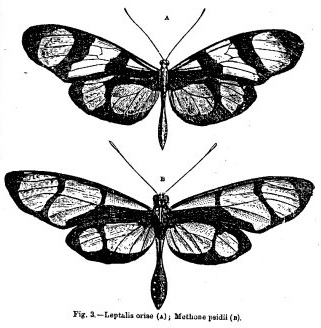
(Fig. 3).
These are only a few out of many examples that might be referred to, but it is necessary to see the specimens themselves in order to appreciate the wonderful change that has taken place from the usual style of colouring of the Pieridæ (still prevalent even in the genus Leptalis itself) to these richly-coloured and strangely-marked forms. Before going further, however, it will be well to show how greatly the two groups, Leptalis and Ithomia, really differ. The accompanying figures (Fig. 4) show the anterior feet, the pupæ, and the larvæ of the two families Pieridæ and Heliconidæ. In the former the feet are long and perfect, with five-
jointed tarsi and bifid claws; the pupa is always supported by a looped thread, and the larva, or caterpillar, is smooth, slightly downy, but without spines or processes of any kind. In the latter the anterior legs are short and imperfect, having no tarsi in the male, and only one or two joints in the female; the pupa is always freely suspended, without any brace or loop, and the larvæ are always furnished with fleshy processes. These combined differences are so important that we may consider the two families to be at least as distinct as deer are from goats, or robins from finches.
Besides the genus Leptalis, several other groups imitate the Heliconidæ in an equally extraordinary manner. A true Papilio (P. pausanias) has the exact colouring of Heliconius clytia—rich steel-blue with yellow bands; while another most remarkable species (P. zagreus) is richly marked with stripes and spots of yellow, brown, and black, so as closely to resemble the Heliconoid Lycorea atergatis. Two genera of Erycinidæ (Ithomeis and Stalachtis), and moths of the genera Castnia, Dioptis, and Pericopis, also resemble species of Heliconidæ in their respective districts in an equally remarkable manner.
In all, or almost all these cases, it has been observed that the mimicking species are much less plentiful than the Heliconidæ which they resemble; and a little consideration will show us that this is essential to the success of the imitation. For if the eatable Pieridæ and other groups were as abundant as the uneatable Heliconidæ, insectivorous animals would soon find it out, and would systematically capture them both, on the chance of getting at least one that they could eat for every one that they were obliged to reject. The fact seems to be, however, that the imitating species are usually very scarce indeed: often not one to a hundred, and sometimes not one to a thousand of the species they imitate; so that they are quite secure among the crowd of uneatable creatures so much resembling them. It may be asked, however, why, as they have the same protection, they do not increase and become nearly as numerous as the uneatable kinds. The answer is, undoubtedly, because their larvæ and pupæ are not protected, and thus suffer great destruction; and this was probably the reason why certain species acquired protection by mimicry in the perfect state as the only means of escaping impending extermination. It is evident that those species which had long and delicate wings and a slow flight, and which, owing to the thinning out of the larvæ and pupæ, were never very abundant, would be most liable to extermination. But these long-winged kinds would in form resemble the Heliconidæ, and any variations of colour tending to make them more like any of the species of that group would be an advantage. Such varieties would therefore have a better chance of escape, and in a long series of generations some of them might at least come to have the wonderful resemblances we now find, while many others, failing to vary sufficiently, have no doubt become extinct.
We will now pass to the African continent, where Acræidæ abound both in species and individuals, while Danaidæ, though few in species, are still sufficiently plentiful in individuals. These take the place of the Heliconidæ of South America, enjoying the same advantages; and they are mimicked in an equally remarkable manner by butterflies of three distinct families—Papilionidæ, Nymphalidæ, and Eurytelidæ; but not by any Pieridæ, which form the bulk of the mimicking species in South America. As an example we may take the Acræa Euryta, a common but remarkable butterfly of West Africa, numerous varieties (or allied species) of which are figured in Mr. Hewitson's "Exotic Butterflies," Vol. IV., Pl. IV., V. (Acræa); and in the same volume under Diadema (a genus of Nymphalidæ), Pl. III., are a series of insects, which it is hard to believe, at first sight, are not also varieties of the same species (Fig. 5). There is also a species of Melanitis (Fam. Eurytelidæ) that resembles the same species of Acræa. Another species, Acræa zetes, has a different style of marking, being red with numerous black spots, and this is very well imitated by another species of Diadema inhabiting the same districts.
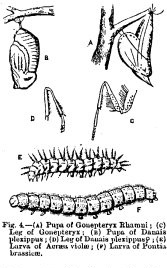
But the most remarkable case known in Africa is presented by a true Papilio which, in several varieties and allied species, mimics the common Danais echeria with its varieties and allied species.
Danais Echeria (Fig. 7, A) is an elongate-winged black butterfly with a group of spots, either buff or white on the front wings, and a broad buff band across the hind wings; varying considerably in different parts of South Africa. Another species, Danais niavius (Fig. 8, A), is larger and handsomer, being deep black with two very large white patches, occupying more than half the surface of the wings. Yet another species, Danais chrysippus, perhaps the commonest of all, is rich orange-red, bordered with black on the hind wings, while nearly the outer half of the upper wings is black crossed by a broken band of pure white. These three butterflies may be said to be totally unlike each other in colour and markings, and each of them is accompanied by a Papilio closely imitating it, which have all been described as distinct species. A gentleman resident in Cape Town (Mr. Roland Trimen), who in 1861 published a book on the butterflies of South Africa, had his attention called to these cases of mimicry by the papers of Mr. Bates and myself, and especially to the fact that very often the females only have protective or imitative colours. He then observed that all these Papilios were, without exception, females, and no male specimen was to be found in any of the rich museums or private collections of this country. He also observed that wherever these butterflies were found, there was also found the large and handsome Papilio merope (Fig. 6), conspicuous by its pale sulphur-yellow colour, the anterior wings black bordered, while the tailed hind wings are crossed by a broken black band. This insect is as completely unlike all the others as possible; but it was always of the male sex, no female being known in any collections, and it was only found in districts where some one or other of the mimicking female Papilios were also found. The two sorts were also seen flying together and chasing each other, just as males and females of the same species often do; so, putting all these things together, he ventured to announce his belief that all were one and the same species.
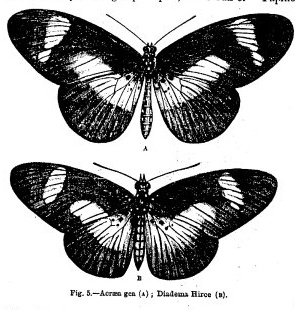
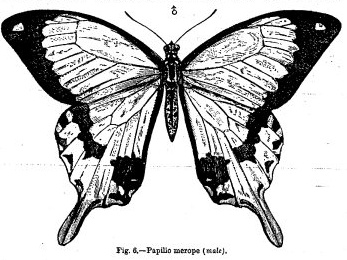
On close examination it was found that there were many minute points of resemblance between these very different-looking insects, and a number of entomologists who were already acquainted with similar facts in other countries, concurred in Mr. Trimen's view. Others, however, strongly opposed it, especially Mr. Hewitson, who possessed the finest collection of butterflies in England. When figuring some of these female Papilios in his work on "Exotic Butterflies,"
he wrote thus:—"That the butterflies now figured are all females, there cannot, I think, be a doubt; but that they are the females of P. merope, as suggested by Mr. Trimen, I do not for one moment believe." And he supported his disbelief by what is certainly a most remarkable fact, that in the adjacent island of Madagascar there is a slight variety of Papilio merope, which has a female almost exactly like itself, while nothing resembling the other females is found there.
In order to settle the question, Mr. Trimen requested his friend Mr. Mansel Weale to endeavour to obtain the eggs or caterpillars of one of the disputed females, and raise therefrom the perfect insect. This was done. Mr. Weale found eggs and larvæ of Papilio cenea (which was the name hitherto given to the female which resembled Danais echeria), and succeeded in raising from them thirteen butterflies. Of these butterflies, seven were males—the well-known yellow-and-black tailed Papilio merope; four were buff-banded females, mimicking Danais echeria (Fig. 7); one was a black-and-white female like Danais niavius (Fig. 8); and one was a red-winged female like Danais chrysippus. Here was positive proof that all these strangely different butterflies are one and the same species, the females mimicking distinct species of Danais!
There are several other interesting facts connected with this butterfly. The caterpillar is the exact colour of the leaves it feeds upon, and is thus protected; the chrysalis is of a remarkable, broad shape, so as exactly to resemble a leaflet of the same plant, and the under side of the male butterfly is of mottled brown tints, and when at rest closely resembles a dead leaf. The perfect male is subject to the attacks of birds, since Mr. Weale saw one actually captured by a large crested fly-catcher; but they fly strongly, darting up and down with great rapidity, and thus no doubt many escape. The flight of the females is, on the other hand, heavy and
slow, and while laying their eggs on the proper food-plant they are especially subject to attack. We may well suppose, then, that they were once near extermination, when some ancestral form varied sufficiently to become something like one of the Danaidæ, and thus obtained the protection necessary for the preservation of the race. Why the Madagascar form of the species did not produce similarly diverse females is not quite clear; but it is certain that in such islands as this, where the number of species both of birds and insects is much less than on continents, the struggle for existence is not nearly so severe. Forests also are denser and more extensive in Madagascar, and thus offer better concealment for insects, which, therefore, may not need the same amount of extraneous protection as on the continent. Having devoted so much space to Papilio merope, we must pass by the many other cases of mimicry that occur in Africa, in order to notice a few of those of India and the Malay Archipelago.
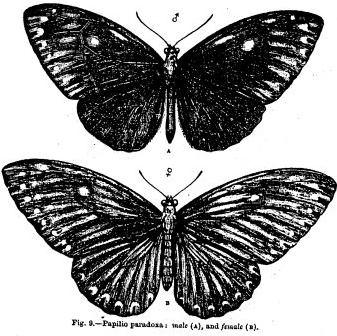
In these countries three genera of Danaidæ, Danais, Euplæa, and Idea, are very abundant, each having a peculiar style of colouring. Danais has elongate wings, and is very varied in colour, but is often semi-transparent greenish or bluish-white with black stripes, and often suffused with yellow or brown. Euplæa has more rounded wings, and is usually dark coloured, with white bands or spots, but is often richly glossed with metallic blue, and very handsome. Idea is very large, with thin papery wings of a whitish semi-transparent colour, marked with round spots or with bands of black. All these forms are closely imitated by various species of Papilio and Diadema, of which only a few of the more remarkable can be here noticed.
One of the most common Danaidæ in Malacca and Borneo is Euplæa midamus (Fig. 10), the male of which has the fore wings of a brilliant metallic blue, with faint bluish-white spots, while the hind wings are uniform brownish black. The female differs considerably, the hind wings being covered with narrow white lines radiating from the body, and having a marginal row of white spots. This is exactly imitated in the two sexes of Papilio paradoxa (Fig. 9), which inhabits the very same districts, but is, comparatively, rare; but the two species are so much alike that I could hardly ever distinguish them when on the wing. The almost equally common Euplæa rhadamanthus is very distinctly coloured, with sharply defined white patches and blue spots on a black ground, very unlike any other butterfly except the Papilio caunus, which imitates it with wonderful accuracy both in markings and in mode of flight. In the Philippine Islands the large white-and-black Idea leuconoe is closely imitated by the fine Papilio idæoides of the same islands.
We have here also two examples of female butterflies being modified for protection, so as to be quite unlike their males. The male of the very common Diadema misippus (Fig. 11) is black, with four conspicuous oval white spots margined with glossy blue. The female is a totally different-looking insect, of a rich orange-brown colour, margined with black and white, and with a white band crossing the black apex of the anterior wings. The idea of their being two sexes of the same species would never strike any one, and would seem utterly preposterous if it were told them for the first time. It is, however, undoubtedly the fact, and the female is an
accurate mimic of the excessively common Danais chrysippus. The male Diadema misippus flies rapidly, and often mounts into the air, while the female flies slowly and keeps low down; and as the species frequents open grounds rather than forests, she would be in great danger of extermination while hovering over the plants on which she lays her eggs, and thus has great need for the protection gained by her resemblance to the uneatable Danais chrysippus which swarms everywhere (Fig. 11).
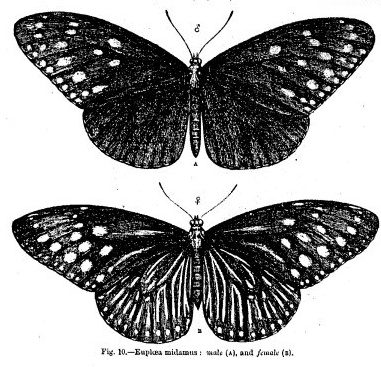
The other case is that of a Diadema from the larger Malay islands, which, owing to its rich metallic blue gloss, had been described, thirty years ago, as the male of another species. On close examination, however, I found it to be a female, while the male is a comparatively dull insect, with hardly any blue gloss and much whiter spots. The two differ, in fact, just as do the sexes of many butterflies, but in a reverse way, the female being here the more brilliant, the male far less so, for which reason I named the species Diadema anomala. The explanation of the anomaly is, that the female mimics the male Euplæa midamus with great accuracy, and thereby acquires the protection which her slow flight and exposure while egg-laying renders necessary. This is a most interesting case, as proving the great power of the need of protection to lead to modifications of colour in the female sex. For purposes of concealment, females generally have less conspicuous tints than their mates, but when protection can be more readily secured by resemblance to species absolutely free from molestation, they can acquire distinct or even brilliant colours, and such as are generally characteristic of the male sex.
Cases of true mimicry among Lepidoptera, such as we have here described, are almost unknown in temperate lands, where the forms of insect life are so much less varied; but there is one very good case in temperate North America, and there are also a few in our own country. In the United States the handsome red-and-black Danais crippus is very common, and there occurs with it one of the Nymphalidæ, Limenitis archippus, which closely resembles it in colour and markings, and is totally unlike all the other species of its own genus. The white moth, Spilosoma menthrasti, mentioned in our former paper as being uneatable, is very abundant, but there is another moth, Diaphora mendica, of which the female only is white, which appears at the same time of the year, and is much less common, so that it is very probable that this species is secure from enemies by being mistaken for the uneatable kind. Our clear-wing moths of the families Sesiidæ and Ægeriidæ are, however, undoubted mimickers, many of the species resembling bees, wasps, or ichneumons, as their names imply. Sphecia crabroniformis, for example, imitates the wasp, Odynerus antilope (Fig. 12); and the common little currant moth, Trochilium tipuliforme, resembles a small black wasp, Odynerus sinuatus, which is abundant in gardens at the same season.
Coming to the order Coleoptera, or beetles, we find numerous cases of the mimicry of protected
by defenceless species. Some extensive groups have an offensive taste like that of the Danaidæ among butterflies. Such are the Eumorphidæ and Hispidæ, and especially many of the Malacoderms, our own red-and-black species of Telephorus, commonly called "soldiers and sailors," being refused by most, if not all, birds. These groups have all conspicuous colours and fly slowly, and many of the species are mimicked by Longicorns, a group of beetles which seems to be particularly subject to the attacks of insectivorous creatures, since a large number of the species have acquired protection, either by their colours, markings, and rugosities, causing them to resemble bark or foliage, or by their habits of concealment, feigning death, or feeding at night. Another group of beetles are protected by the excessive hardness of their integuments, which render them uneatable to most insectivorous birds. Such are many of the Curculionidæ and Anthribidæ, and both these groups are often mimicked by Longicorns in a most perfect manner. The most curious example is, perhaps, that of the Longicorns—Doliops curculionides and D. geometrica of the Philippines, which, both in shape and colours, closely resemble weevils of the genus Pachyrhynchus, peculiar to the same islands. This is the more remarkable, because the insects imitated are marked in a most unusual manner with geometrical patterns, and possess the most brilliant metallic colours. The Eastern tiger-beetles of the genera Collyris and Therates are also mimicked, the former by a Longicorn, Collyrodes Lacordairei, the latter by a species of Heteromera, and in both cases the imitation is very exact.
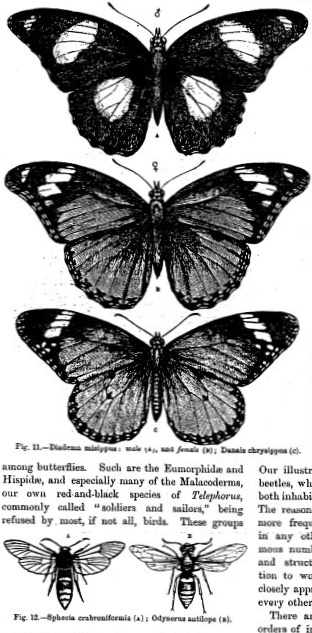
The same group—Longicorns—also mimic many other insects which it is to their advantage to be mistaken for. Different species resemble bees, wasps both blue and yellow, saw-flies, ants, and the strong-smelling Hemiptera. Our illustration (Fig. 13) represents one of these beetles, which exactly resembles a large blue wasp, both inhabiting the same districts in South America. The reason why cases of mimicry occur so much more frequently in this family of beetles than in any other, is, probably, because their enormous numbers and endless modifications of form and structure offer facilities for natural selection to work upon, some of them more or less closely approximating to the form and colouring of every other family of the order.
There are also many cases in which distinct orders of insects mimic each other. Moths which imitate bees and wasps have already been mentioned. In the Philippine Islands two very singular cases occur. An insect of the cricket family (Condylodera
tricondyloides) is so exactly like a tiger-beetle of the genus Tricondyla, that so old and learned an entomologist as Professor Westwood placed it among them in his cabinet, and kept it there for a long time before he found out his mistake. Another species of the same cricket family (Scepastus pachyrhynchoides) mimics a species of Pachyrhynchus (P. venustus), a beetle as totally unlike a Tricondyla as it is possible to find.
We cannot now do more than refer to the numbers of two-winged flies which mimic bees and wasps,2 or the spiders which resemble ants; but we must just mention the Mantis which Mr. Bates found on the banks of the Amazon exactly resembling the white ants it feeds upon, and the crickets of the genus Scaphura, which accurately mimicked sand-wasps, the reason being that the sand-wasps are especially fond of crickets with which to provision their nests. These defenceless creatures have, therefore, in many distant countries, been preserved, by acquiring the form and colouring of stinging Hymenoptera, carnivorous Cicindelidæ, or hard-shelled Curculionidæ.
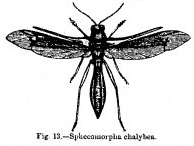
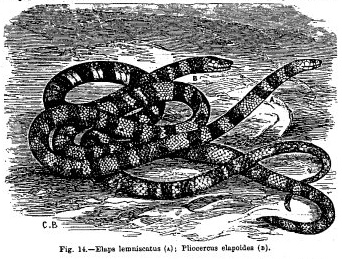
Owing to the comparative stability of the external form of the higher animals, and the important outward differences between the various groups, the facilities for the production of mimicry rarely exist in their case. Yet there are a few undoubted examples of very great interest. The chief venomous snakes of America belong to the Crotalidæ or "Pit-vipers" (of which the rattlesnake is the most remarkable), and are known by their broad and almost triangular heads; but there is one genus of poisonous snakes in America—Elaps, which belongs to a totally distinct family, and has a small oval head just like many harmless snakes. These, therefore, would be attacked and occasionally killed by snake-eating birds and quadrupeds, unless they had some distinctive mark as a notice of their possessing poison-fangs; and they have got this mark in a peculiar style of colouring different from that of any other snakes. They are all coloured with alternate black, red, or yellow rings from head to tail, giving them a most elegant and altogether peculiar appearance—a distinctive livery pointing them out as uneatable, in the same way that the Heliconidæ are pointed out amid the host of eatable South American butterflies. Now, just as the eatable and defenceless butterflies of the genera Leptalis and Stalachtis have taken on the livery of the Heliconidæ as a protection, so there are two or three genera of harmless snakes which have taken on the peculiar livery of those poisonous snakes, at least seven or eight species being known, each accurately mimicking in different parts of the country the particular species of Elaps found there. As an example we may name the deadly Elaps
2 This is often so remarkable as to deceive the best observers. One of our first entomologists, Mr. McLachlan, informs me that once when out with a party of collectors he captured what he took to be a pair of humble-bees, and gave them to the late Mr. Frederick Smith, the greatest authority on bees, who carefully secured them in his collecting-box; and it was only on reaching home and proceeding to set them out that he discovered that they were not bees at all, but flies of the genus Volucella, which are parasitic on humble-bees, and are thus disguised in order that they may enter their nests with impunity in order to deposit their eggs.
lemniscatus, of Mexico, which has broad black bands on a red ground, each band divided into three parts by narrow yellow rings; and this very peculiar colouring is exactly copied in the harmless Pliocercus elapoides of the same country (Fig. 14). We can hardly have more wonderful and more conclusive cases of warning colour and protective mimicry than are afforded by these various species of American snakes.
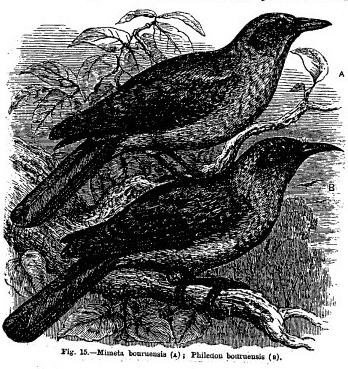
Birds offer a few undoubted cases of mimicry, the most perfect being that of some species of Mimeta, a genus of brown orioles, which mimic Philedon, a genus of honeysuckers (Fig. 15). The latter birds, it may be remarked, are the largest of their family, and are very noisy and pugnacious; they are also very plentiful, and will band together to drive away crows and even hawks that intrude among them. We may presume, therefore, that they are generally unmolested, and it would thus be of use to any weaker bird to be mistaken for them. The orioles, though nearly as large, are decidedly weaker birds, and are far less numerous, and thus correspond to the general character of mimicking species. In the island of Bouru, one of the Moluccas, there is a peculiar species of Philedon (P. bouruensis), and in the same island a peculiar species of Mimeta (M. bouruensis), which are so much alike that in a great French work, the "Voyage de L'Astrolabe," the oriole is figured and described as a honeysucker under the name of Philedon bouruensis! the two birds belonging to families at least as distinct as thrushes and crows. The manner in which the imitation is effected is very curious. The Philedon bouruensis, as in almost all the species of the genus, has a large bare patch of black skin round the eyes; this is copied in the Mimeta bouruensis by a patch of black feathers. The narrow scale-like feathers on the crown of the Philedon are imitated by a dark line on the broader feathers of the Mimeta. On the neck of the Philedon the feathers are recurved, showing their pale under-surfaces and forming a kind of ruff or cowl which has given to them the name of friar-birds, and this is represented by a pale band in the Mimeta; and lastly, the bill of the Philedon has a protuberant keel at the base, and the Mimeta has the same character, though it is not found in the allied species. The colours of this pair of birds are simply brown, darker above and lighter below; but in the adjacent island of Ceram there is another species, Philedon subcornutus, which has a great deal of ochre-yellow in its plumage, and this is exactly imitated by the corresponding Mimeta forsteni, both being confined to this single island. If it could be thought that the resemblance in the one case might be accidental, and that their occurring in the same island was also a coincidence, the occurrence of another pair in another island renders this explanation inadmissible; but to any one who has comprehended the general principles of mimicry already set forth, it will be clear, that these are of exactly the same nature in the case of these birds, and can be explained only in the same way.
The family of birds which presents the greatest number of cases of mimicry is undoubtedly that of the cuckoos, the reason being that the species are
all of very weak structure and utterly defenceless. Many of the true cuckoos are coloured exactly like hawks, and this is particularly the case with those of the genus Hierococcyx, which are named hawk-cuckoos. Dr. Jerdon states that H. varius, a common Indian species, undergoes changes of plumage exactly corresponding to that of an Indian sparrow-hawk, Micronisus badius, and that it is often mistaken for that species by other birds. Another Indian cuckoo (Surniculus dicrurioides) is black with a deeply-forked tail, and is so exactly like the common King-crow (Dicrurus macrocercus) as to be mistaken for it. It is believed that it lays its eggs in the nest of the latter bird, and that this is the reason of its remarkably perfect mimicry; but no doubt it is also thereby protected from the attacks of hawks, as the king-crows are very pugnacious and aggressive birds, which attack and drive away hawks, kites, and crows, a habit from which they have obtained their popular name. In Sumatra and Borneo there is a large ground cuckoo (Carpococcyx radiatus) handsomely coloured with metallic purple and red, so as to resemble the pheasants of the country of the genus Euplocamus.
Among mammalia there are hardly any examples of one species imitating another of a different group for the purpose of protection, the best perhaps being the curious insectivorous Tupaias of the Malay countries, which almost exactly resemble squirrels both in their colours and their bushy tails, but which belong to a totally distinct order. If this resemblance is not accidental it must be for the purpose of enabling them to approach their insect prey under the guise of harmless squirrels. Another case is that of the Aard-wolf (Proteles), which has weak jaws, and feeds on white ants and carrion, but which is coloured and spotted exactly like the savage hyæna; and it may avoid the attacks of the more powerful carnivora, owing to the very general fear of the terrific bite of the animal it resembles.
In describing the phenomena of mimicry it is difficult to avoid conveying the impression, that there is some voluntary action in the creatures that thus seem to disguise themselves in order to be mistaken for quite different creatures; but those who have understood the explanation given in our former paper, of the mode in which ordinary protective resemblances have been brought about, will not fall into this mistake. If an Arctic bird has become white, and a forest bird green; if one insect is coloured like a leaf, another like the bark it clings to, we can easily see that it is only a step further in the same process for one insect to become exactly like another insect.
Some persons, however, have objected, that so many steps are required in the process of making a white Leptalis resemble a highly coloured Ithomia, that the chances against the necessary variations occurring are infinite. It is forgotten, however, that both the groups to which these genera belong have been undergoing constant changes for countless generations. Many Pieridæ have dusky, or yellow, or red markings, and many Heliconidæ have comparatively little colouring; and if we go back to the remote epoch when the Heliconidæ and Pieridæ were both much nearer to their common lepidopterous ancestor, we can have no difficulty in believing that species of one family might sometimes not be very unlike species of the other family. Now if at this remote period the Heliconidæ began to acquire the peculiar nauseous secretion which became a protection to them, and allowed them to increase and vary greatly, and to acquire the brilliancy of colour, length of wings, and slowness of flight which now distinguish them, it is not improbable that here and there one of the Pieridæ should be sufficiently like them to be mistaken for one of the group, and thus acquire a partial protection. This protection would inevitably increase by the simple action of natural selection, those variations of the ancestral Leptalis or Euterpe having the advantage which followed the variations of the ancestral Ithomia or Mechanitis, and thus, in the course of thousands or perhaps millions of generations, that close resemblance which we now see would be brought about. It must be remembered too, that the imitation would be rendered more accurate as time went on, owing to the increased acuteness of the insectivorous enemies of the butterflies. An imperfect resemblance would, after a time, be found out, and this would lead to the selection and perpetuation of more and more perfect mimicry. It may be asked, how do so many species of Leptalis still survive, which are yellow and white and not at all like Heliconidæ? and we can only give a guess in reply. Many of them are more rapid fliers; some may have different habits, and in some the larvæ may have better means of concealment and protection. As Mr. Darwin has remarked, we can seldom say why one of our native insects should be very common while another is very rare, and to answer similar questions regarding tropical insects is, of course, impossible. Our ignorance in this respect does not, however, prevent us from acquiring knowledge in other directions, and does not in the least affect the
extraordinary facts of mimicry, only a small selection of which have here been laid before our readers. These facts are so varied and so extraordinary, they occur in so many distinct groups of animals, and in so many different parts of the world, and they have been so carefully studied by several good observers, that not a doubt remains as to their reality; while no theory but that of Natural Selection affords—in my opinion—any intelligible explanation of them.